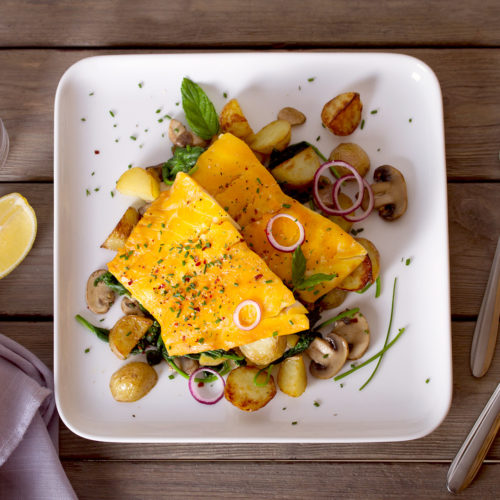Hake
QUICK FACTS
Nutrition Value: High in Protein
Ways to cook: Pan Fry, Grill, Pickle, Poached, Steamed, Baked
Portion Size per person: 250g – 300g
Taste: Hake is a soft, moist fish that is perfect for battering, grilling, frying, baking & Pickling. It is a versatile ingredient thanks to its mild flavour; people that don’t enjoy overly “fishy tasting” seafood should find hake acceptable. In general, hake has a mild, slightly sweet taste. Its subtle flavour makes it the perfect blank canvas for adding a diverse range of seasonings.
Sides
- Roast sweet potatoes with sriracha & lime.
- Easy green beans with browned butter Almondine.
- Lemon Tahini Salad with Lentils, beets & carrots
- Portobello Mushrooms stuffed with Barley Risotto
- Panzanella Salad
- Sweet potato & Rocket Salad
- Grilled Veggie Skewers
- Tartar Sauce
- French fries
- Cheese Cauliflower rice
- Rice Pilaf
Similarities: Hake is similar to Cod, Haddock, Pollock, or Tilapia.
To drink with Hake: Sauvignon Blanc, Chardonnays, Pinot Grigio, Pinot Gris, Beer, Ceviche White Peach Sangria
Best way to cook
Best way to cook
Pan-frying: You can choose to fry your fish as is or cover it in flour or breadcrumbs. Using the extra coating will give your fish more texture and body. If you’re going to dip it in flour, soak the fish in a bowl of milk for 3 to 5 minutes, before covering it in flour or breadcrumbs. This will help the coating stick to the fish.
Get your pan ready for frying by pouring a few tablespoons of vegetable oil into it. You can also use clarified butter which will taste great on the fish. Heat the pan until the oil slides around easily. You can splatter a few drops of water in the pan – if the water sizzles, it’s ready for your fish. Place the fish flesh side down in the pan – the side you’ll be presenting to your diner (the non-skin side).
Once your fish is in the pan, slide a spatula gently underneath to prevent it from sticking. Cook the fish for 3 to 4 minutes on one side and then flip it. Fish usually cooks for 10 minutes per inch of thickness. Use a wide spatula to prevent breaking the fish. Cook for another 3-4 minutes or until the flesh turns pearly white and flakes easily with a fork. Carefully lift it out of the pan and serve immediately.
Grilling: Grilling fish gives you a great advantage as you have complete control over the temperature. Always coat your fish with oil or fat to prevent sticking. As you’re heating your grill, cover the grate loosely with aluminum foil. The intense heat will cause any residue to dissolve, starting the cleaning process for you. This also minimizes sticking.
Blast the heat to 288°C. Remove the aluminum foil. Using a grill brush, scrape the grate clean. Fold a few sheets of paper towels into a small pad, dip them in oil using tongs and rub over the bars of the grate until it looks glossy. Choose fillets that are thick and sturdy for grilling and can stand up to the intense heat of live fire. Cut your fish into portions that have an even thickness to ensure you don’t have any dry or undercooked parts.
Coat your fish with some olive oil, salt, and pepper and place it skin-side down and diagonally on the grill. This makes it easier to flip the fish as it’s lying at an angle. The fish will take 8 minutes to cook through per inch of thickness, taking about 3-5 minutes per side. Reduce the heat to medium, cover the grill and let it cook. When cooked properly, the meat will be firm to the touch, flake easily with a fork, and appear opaque all the way through.











